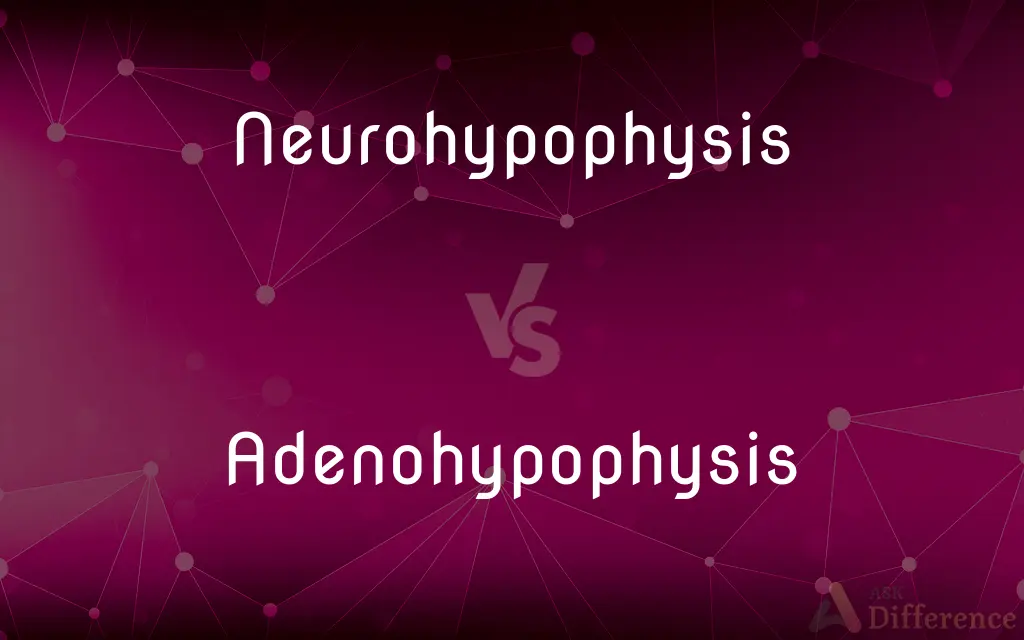Neurohypophysis vs. Adenohypophysis — What's the Difference?
By Tayyaba Rehman & Maham Liaqat — Updated on April 18, 2024
Neurohypophysis releases hormones directly from the brain, primarily oxytocin and vasopressin, while adenohypophysis synthesizes and secretes hormones like growth hormone and prolactin.

Difference Between Neurohypophysis and Adenohypophysis
Table of Contents
ADVERTISEMENT
Key Differences
The neurohypophysis, also known as the posterior pituitary, is an extension of the hypothalamus, directly releasing hormones it receives from the brain. In contrast, the adenohypophysis, or anterior pituitary, is an independent gland that synthesizes and secretes its own hormones based on signals from the hypothalamus.
Neurohypophysis stores and secretes two main hormones: oxytocin and vasopressin (antidiuretic hormone), which are produced in the hypothalamus. On the other hand, adenohypophysis produces several hormones including growth hormone (GH), prolactin, follicle-stimulating hormone (FSH), and others, which regulate diverse body functions.
The hormones from the neurohypophysis primarily focus on water balance, childbirth, and lactation, emphasizing the gland's role in immediate physiological responses. Conversely, hormones from the adenohypophysis influence growth, metabolism, and reproductive processes, showcasing a broader regulatory spectrum.
Functionally, the neurohypophysis acts more as a storage and release site for hormones transported along axons from the hypothalamus. Whereas, the adenohypophysis actively engages in the hormonal feedback loops necessary for maintaining homeostasis and responding to internal and external changes.
In terms of feedback regulation, the neurohypophysis responds directly to neural inputs from the hypothalamus, reflecting its integration within the neural structures. In contrast, adenohypophysis is regulated by releasing and inhibiting hormones from the hypothalamus, indicating a more complex endocrine control.
ADVERTISEMENT
Comparison Chart
Primary Function
Hormone release
Hormone synthesis and secretion
Connection to Hypothalamus
Direct neural connection
Regulated via blood-borne signals
Key Hormones
Oxytocin, Vasopressin
Growth hormone, Prolactin, FSH, etc.
Physiological Roles
Water balance, childbirth, lactation
Growth, metabolism, reproduction
Regulation Mechanism
Neural signals from hypothalamus
Hypothalamic releasing/inhibiting hormones
Compare with Definitions
Neurohypophysis
Responds to neural signals.
The neurohypophysis releases hormones when signaled by the brain.
Adenohypophysis
The anterior, hormone-producing part of the pituitary gland.
The adenohypophysis secretes growth hormone to stimulate development.
Neurohypophysis
Involved in physiological responses.
The neurohypophysis aids in water retention through vasopressin release.
Adenohypophysis
Synthesizes various hormones.
Hormones like prolactin from the adenohypophysis regulate lactation.
Neurohypophysis
An extension of the brain involved in hormone release.
The neurohypophysis releases oxytocin during childbirth.
Adenohypophysis
Influences long-term body functions.
The adenohypophysis affects metabolism through its hormonal outputs.
Neurohypophysis
The posterior part of the pituitary gland.
Vasopressin from the neurohypophysis regulates kidney function.
Adenohypophysis
Regulated by hypothalamic hormones.
The adenohypophysis responds to signals like GHRH.
Neurohypophysis
Stores hormones produced by the hypothalamus.
Hormones stored in the neurohypophysis include vasopressin and oxytocin.
Adenohypophysis
Part of complex endocrine feedback loops.
Feedback loops involving the adenohypophysis help maintain homeostasis.
Neurohypophysis
The posterior portion of the pituitary gland, having a rich supply of nerve fibers and releasing oxytocin and vasopressin.
Adenohypophysis
The anterior glandular lobe of the pituitary gland that secretes many hormones, including ACTH, prolactin, and somatotropin.
Neurohypophysis
(anatomy) The posterior lobe of the pituitary gland, responsible for the release of oxytocin and antidiuretic hormone (ADH), also called vasopressin.
Adenohypophysis
(anatomy) The anterior lobe of the pituitary gland, producing and secreting several peptide hormones that regulate many physiological processes including stress, growth, and reproduction.
Neurohypophysis
The posterior lobe of the pituitary body; primarily glandular in nature
Adenohypophysis
The anterior lobe of the pituitary body; primarily glandular in nature
Common Curiosities
What are the primary functions of hormones from the adenohypophysis?
Hormones from the adenohypophysis regulate growth, reproductive functions, and metabolism.
What is the main difference between neurohypophysis and adenohypophysis?
The neurohypophysis is a storage and release site for hormones produced by the hypothalamus, while the adenohypophysis synthesizes and secretes its own hormones.
How does the neurohypophysis receive its hormones?
Hormones are transported to the neurohypophysis via axons from the hypothalamus.
What hormones are released by the neurohypophysis?
The neurohypophysis primarily releases oxytocin and vasopressin.
What are common disorders related to the adenohypophysis?
Common disorders include acromegaly and pituitary dwarfism, related to abnormal hormone production.
How do feedback loops affect adenohypophysis function?
Feedback loops involving hormones from the adenohypophysis help regulate its secretion based on body needs.
What regulates the secretion of hormones in the adenohypophysis?
The adenohypophysis is regulated by hypothalamic releasing and inhibiting hormones.
How do the roles of oxytocin and growth hormone differ?
Oxytocin, released from the neurohypophysis, primarily affects childbirth and lactation, whereas growth hormone from the adenohypophysis affects overall body growth.
What impact does vasopressin have on the body?
Vasopressin, from the neurohypophysis, plays a crucial role in regulating water retention and blood pressure.
What role does the adenohypophysis play in reproduction?
It secretes FSH and LH, which are crucial for reproductive processes.
How does stress affect hormone release from the adenohypophysis?
Stress can increase the secretion of ACTH from the adenohypophysis, which in turn stimulates cortisol release.
What is the clinical importance of understanding the differences between the neurohypophysis and adenohypophysis?
Understanding these differences is crucial for diagnosing and treating pituitary gland disorders effectively.
Are there any common disorders associated with the neurohypophysis?
Disorders such as diabetes insipidus are linked to dysfunction in the neurohypophysis.
Can the adenohypophysis function independently of the hypothalamus?
No, the adenohypophysis requires signals from the hypothalamus to function properly.
What is the significance of neural connections to the neurohypophysis?
Neural connections allow the neurohypophysis to quickly respond to changes in the body's environment.
Share Your Discovery

Previous Comparison
Comcast vs. Xfinity
Next Comparison
Genuinely vs. SincerelyAuthor Spotlight
Written by
Tayyaba RehmanTayyaba Rehman is a distinguished writer, currently serving as a primary contributor to askdifference.com. As a researcher in semantics and etymology, Tayyaba's passion for the complexity of languages and their distinctions has found a perfect home on the platform. Tayyaba delves into the intricacies of language, distinguishing between commonly confused words and phrases, thereby providing clarity for readers worldwide.
Co-written by
Maham Liaqat













































